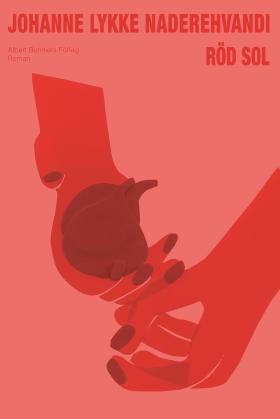
Röd sol
(Red Sun)
by Johanne Lykke Naderehvandi
reviewed by Sophie Ruthven
We live in an overheating world. Summer has become a soporific time laced with both the threat of and actual, devastating natural disasters. Against the backdrop of these events life still demands individual concerns and choices. Reading Red Sun at the height of summer is akin to entering a fever dream.
India and Kallas live a quietly idyllic urban life in an imperfect time. Their deep love for one another and complete enjoyment of the day-to-day ensures their world is just the right size for two. The space between them is expansive, offering room for multitudes of sensory experiences sharp as crystal. All the same, their surroundings are unbearably hot. This seeps into everything to produce an environmental Gothic effect of threat and anxiety from the off, so that when they go to stay in the countryside with Desma and her partner Lafayette, disaster seems to loom despite the refreshment afforded by a greener, less urban landscape and the open water of the sea.
The sense of dread is cranked up notch by notch as three children mysteriously arrive without guardians and are soon followed by an uncontrollable wildfire that threatens to engulf everything in its path. India and Kallas flee the natural disaster with the children – despite never having wanted any of their own – and head back to the baking metropolis. The sense of dread follows with them.
Yet is the biggest threat really the heat of the sun and the fire, or is it the children? What it means to be a guardian, what a family really is: I felt these were the matters Red Sun invites its reader to consider. It’s impossible to ‘partially’ have children, whether they’re biologically yours or not. Being the guardian of children is an all-in decision that takes your life down a particular path. And what do we mean by ‘our’ children? Tied up with this is the existential question of what you are when you adopt the role of a guardian, and whether families with children at their base really just need ritual and symbolism: the moment the children join India and Kallas, it seems like the most natural thing in the world for them to be part of the daily ritual of drinking bitter tea, of excursions, as if this family – their family – have always existed in this particular constellation. The space they had for each other naturally had space for this too, somehow.
India’s work at the university revolves around symbols and interpretation, and Red Sun invites semiotic readings, as the richness of its language holds the reader’s eye over particular objects and scenes to drink in their solidity. It’s worth reading Red Sun for the language alone, something likely anticipated by readers of Naderehvandi’s previous novel Strega. Objects and actions are illumined in the most sensuous of prose, which left me with the sensation of watching a slow-moving film or standing in front of a hue-rich painting.
The assistant wraps the flowers in newspaper and ties it off with string. Behind the counter hangs a dirty mirror, where the plants and the nape of the assistant are reflected, drenched in the light from the fitting. A bead of sweat runs down from India’s hairline, over her brow and nose, into the dip above her Cupid’s bow, rolls onwards and disappears into her mouth. The saltiness makes her think of the sea…
The mood of the novel and India’s own observations led me often to attempt to decipher the many components of this beautifully rendered world, even when contemplation itself would have been enough. The driving sense that something is about to go wrong primes the mind for a search for meaning and ‘sense’ in what it encounters. When faced with a mystery, with unknown threats, we try to tell a story over the story. That goes for the reader of Red Sun as well as India. A hyperawareness that then leads to a growing sense of unease and moments of the truly uncanny.
Exact locations are never disclosed. At times I was compelled to force a name for the setting in my head – this must be the Mediterranean, surely, but are we in Croatia? Greece? – though the anonymity of the setting ensures that the reader focuses only on what’s presented to them, the sensations, images and conversations of which there are plenty rich enough to render any pre-conceived notions of place or character unnecessary.
The dreamlike, sharp relief of Naderehvandi’s world left me with a desire to respond to my own surroundings with the same level of visual care, and for that alone, her writing truly feels like a gift. I found myself spending longer pondering fresh groceries than I would normally, and wanting to ritualise the drinking of tannin-rich tea before bed. The dream of Red Sun stays in your mind’s eye long, long after turning the final page.

Röd sol
Albert Bonniers Förlag 2023
312 pages
Foreign rights: RCW Literary Agency
Johanne Lykke Naderehvandi’s previous novel Strega (under the name of Johanne Lykke Holm) was published in Saska Vogel’s English translation by Lolli Editions in 2022, winning an English PEN Award and the 2023 Bernard Shaw Prize. Saskia Vogel discussed the translation of this novel in an interview published in SBR 2024:1.
